- Home
- Barbara Kingsolver
Animal, Vegetable, Miracle Page 6
Animal, Vegetable, Miracle Read online
Page 6
On the new edge of springtime when I stand on the front porch shading my eyes from the weak morning light, sniffing out a tinge of green on the hill and the scent of yawning earthworms, oh, boy, then! I roll like a bear out of hibernation. The maple buds glow pink, the forsythia breaks into its bright yellow aria. These are the days when we can’t keep ourselves indoors around here, any more than we believe what our eyes keep telling us about the surrounding land, i.e., that it is still a giant mud puddle, now lacking its protective covering of ice. So it comes to pass that one pair of boots after another run outdoors and come back mud-caked—more shoes than we even knew we had in the house, proliferating like wild portobellos in a composty heap by the front door. So what? Noah’s kids would have felt like this when the flood had almost dried up: muddy boots be hanged. Come the end of the dark days, I am more than joyful. I’m nuts.
Our household was a week into high spring fever when Lily and I decided it was safe to carry out some of the seedlings we’d started indoors on homemade shelves under fluorescent bulbs. The idea of eating from our home ground for a year had moved us to start a grocery store from seed. We’d been tucking tomatoes into seed flats since January, proceeding on to the leafy greens and broccoli, the eggplants, peppers, okra, and some seed catalog mysteries we just had to try: rock melons, balloon flowers! By mid-March our seed-starting shelves were overwhelmed.
Then began the lover’s game we play with that irresistible rascal partner, March weather. He lulls us into trust one day with smiles and sunshine and daytime highs in the sixties, only to smack us down that very night with a hard freeze. On our farm we have a small unheated greenhouse that serves as a halfway house, a battered-seedling shelter if you will, where the little greenlings can enjoy the sun but are buffered from cold nights by five degrees or so. Usually that’s enough of a safety margin. But then will come a drear night when the radio intones, Lows tonight in the teens, and we run to carry everything back inside, dashing in the back door, setting flats all over the table and counters until our kitchen looks like the gullet and tonsils of a Chia Pet whale.
This is what’s cruel about springtime: no matter how it treats you, you can’t stop loving it. If the calendar says it’s the first day of spring, it is. Lily and I had been lured up the garden path, literally, carrying flats of broccoli, spinach, and cilantro seedlings to the greenhouse on the bank just uphill from the house.
The greatest rewards of living in an old farmhouse are the stories and the gardens, if they’re still intact in any form. We are lucky enough to have both. The banks all around us are crowded with flowering shrubs and hummocks of perennial bulbs that never fail to please and startle us, like old friends leaping from behind the furniture to yell, “Surprise!” These flowers are gifts from a previous century, a previous dweller here—a tale, told in flowers, of one farm wife’s fondness for beauty and this place. In a few more months we’d be drunk on the scent of Lizzie Webb’s mock oranges and lilacs, but the show begins modestly in April with her tiny Lenten roses, white-petaled snowdrops, and the wildish little daffodils called jonquils that have naturalized all over the grassy slopes. As Lily and I walked single file up the path to the greenhouse, I noticed these were up, poking their snub, yellow-tipped noses through a fringe of leaves.
“Oh, Mama,” Lily cried, “look what’s about to bloom—the tranquils.”
There went the last of the needles of ice around my heart, and I understood I’d be doomed to calling the jonquils tranquils for the rest of my days. Lily is my youngest. Maybe you know how these things go. In our family, those pink birds with the long necks are called flingmos because of how their real name was cutely jumbled by my brother’s youngest child—and that was, yikes, twenty years ago.
That’s how springtime found us: grinning from ear to ear, hauling out our seedlings, just as the rest of our neighborhood began to haul out the plastic lawn flingmos and little Dutch children kissing and those spooky plywood silhouettes of cowboys leaning against trees. Lawn decoration is high art in the South, make no mistake about it. Down here in Dixie, people do not just fling out a couple or three strands of twinkly lights in December and call it a year, no ma’am. In our town it’s common practice for folks to jazz up their yards even for the minor decorative occasions of Valentine’s Day and the Fourth of July, and on Easter to follow an unsettling tradition of hanging stuffed bunny rabbits from the crab apple trees (by the neck, until dead, to all appearances). If they’re serious about it, they’ll surround the cottontailed unfortunate with a ferociously cheerful crop of dangling plastic eggs.
I grew up in this territory, and my recollection from childhood is that every community had maybe just one person with a dolled-up yard—such as my paternal grandmother, who was known to be gifted in the decor department—but for the average citizen it was enough to plop a tire out there and plant petunias in it. Or marigolds in a defunct porcelain toilet, in neighborhoods with a different sense of decorum. But those days are gone, my friend, and never more will it be so easy to keep up with the Joneses.
Our recent construction work on the farmhouse had turned the front yard into what you might euphemistically call a blank slate. (Less euphemistically: mud.) With my hands full of vegetable seedlings and the wild rumpus of spring in my head, I considered planting lettuces and red Russian kale in place of a lawn, maybe in the visage of the Mona Lisa. Or letters that spelled out something, like “MOW ME.” But in the end, after considering the fact that nobody can see our house from the road, I desisted in fancying myself the Michelangelo of Kale. These greens would go into the vegetable bed, though I’ll tell you I am not above tucking a tomato or two into a handsome perennial border. Vegetables are gorgeous, especially spring greens, arriving brightly as they do after a long winter of visually humble grains and stored root crops.
Bronze Arrowhead lettuces, Speckled Trout romaine, red kale—this is the rainbow of my April garden, and you’ll find similar offerings then at a farmers’ market or greengrocer. It’s the reason I start our vegetables from seed, rather than planting out whatever the local nursery has to offer: variety, the splendor of vegetables. I have seen women looking at jewelry ads with a misty eye and one hand resting on the heart, and I only know what they’re feeling because that’s how I read the seed catalogs in January. In my mind the garden grows and grows, as I affix a sticky note to every page where there’s something I need. I swoon over names like Moon and Stars watermelon, Cajun Jewel okra, Gold of Bacau pole bean, Sweet Chocolate pepper, Collective Farm Woman melon, Georgian Crystal garlic, mother-of-thyme. Steven walks by, eyes the toupee of yellow sticky notes bristling from the top of the catalog, and helpfully asks, “Why don’t you just mark the one you don’t want to order?”
Heirloom vegetables are irresistible, not just for the poetry in their names but because these titles stand for real stories. Vegetables acquire histories when they are saved as seeds for many generations, carefully maintained and passed by hand from one gardener to another. Heirlooms are open-pollinated—as opposed to hybrids, which are the onetime product of a forced cross between dissimilar varieties of a plant. These crosses do rely on the sex organs of the plant to get pollen into ovaries, so they’re still limited to members of the same species: tall corn with early corn, for example, or prolific cucumbers with nonprickly ones, in blends that combine the ideal traits of both parents for one-time-only offspring. These whiz-kid hybrid seeds have slowly colonized and then dominated our catalogs and our croplands. Because of their unnatural parentage they offer special vigor, but the next generation from these crosses will be of an unpredictable and mostly undesirable character. Thus, hybrid seeds have to be purchased again each year from the companies that create them.
Genetic modification (GM) takes the control even one step further from the farmer. Seed companies have made and sold hybrids since the 1920s (starting with the Hybrid Corn Company, now a subsidiary of DuPont), but GM is a newer process involving direct manipulation of genes in the laboratory. Fre
ed from the limits of natural sex, the gene engineer may combine traits of creatures that aren’t on speaking terms in the natural world: animal or bacterial genes spliced into the chromosomes of plants, for example, and vice versa. The ultimate unnatural product of genetic engineering is a “terminator gene” that causes a crop to commit genetic suicide after one generation, just in case some maverick farmer might want to save seed from his expensive, patented crop, instead of purchasing it again from the company that makes it.
By contrast to both GM and hybridization, open-pollinated heirlooms are created the same way natural selection does it: by saving and reproducing specimens that show the best characteristics of their generation, thus gradually increasing those traits in the population. Once bred to a given quality, these varieties yield the same characteristics again when their seeds are saved and grown, year after year. Like sunshine, heirloom seeds are of little interest to capitalism if they can’t be patented or owned. They have, however, earned a cult following among people who grow or buy and eat them. Gardeners collect them like family jewels, and Whole Foods Market can’t refrain from poetry in its advertisement of heirlooms, claiming that the tomatoes in particular make a theatrical entrance in the summertime, “stealing the summer produce scene. Their charm is truly irresistible. Just the sound of the word ‘heirloom’ brings on a warm, snuggly, bespectacled grandmother knitting socks and baking pies kind of feeling.”
They’ve hired some whiz-bang writers down at Whole Foods, for sure, but the hyperbolic claims are based on a genuine difference. Even a child who dislikes tomatoes could likely tell the difference between a watery mass-market tomato and a grandmotherly (if not pie-baking) heirloom. Vegetables achieve historical status only if they deserve it. Farmers are a class of people not noted for sentimentality or piddling around. Seeds get saved down the generations for a reason, or for many, and in the case of vegetables one reason is always flavor. Heirlooms are the tangiest or sweetest tomatoes, the most fragrant melons, the eggplants without a trace of bitterness.
Most standard vegetable varieties sold in stores have been bred for uniform appearance, mechanized harvest, convenience of packing (e.g. square tomatoes), and a tolerance for hard travel. None of these can be mistaken, in practice, for actual flavor. Homegrown tomatoes are famously superior to their supermarket counterparts, but the disparity is just as great (in my experience) for melons, potatoes, asparagus, sweet corn, broccoli, carrots, certain onions, and the Japanese edible soybeans called edamame. I have looked for something to cull from my must-grow list on the basis of its being reasonably similar to the supermarket version. I have yet to find that vegetable.
How did supermarket vegetables lose their palatability, with so many people right there watching? The Case of the Murdered Flavor was a contract killing, as it turns out, and long-distance travel lies at the heart of the plot. The odd notion of transporting fragile produce dates back to the early twentieth century when a few entrepreneurs tried shipping lettuce and artichokes, iced down in boxcars, from California eastward over the mountains as a midwinter novelty. Some wealthy folks were charmed by the idea of serving out-of-season (and absurdly expensive) produce items to their dinner guests. It remained little more than an expensive party trick until mid-century, when most fruits and vegetables consumed in North America were still being produced on nearby farms.
Then fashion and marketing got involved. The interstate highway system became a heavily subsidized national priority, long-haul trucks were equipped with refrigeration, and the cost of gasoline was nominal. The state of California aggressively marketed itself as an off-season food producer, and the American middle class opened its maw. In just a few decades the out-of-season vegetable moved from novelty status to such an ordinary item, most North Americans now don’t know what out-of-season means.
While marketers worked out the logistics of moving every known vegetable from every corner of the planet to somewhere else, agribusiness learned to breed varieties that held up in a boxcar, truck, or ship’s cargo hold. Indestructible vegetables, that is to say: creations that still looked decent after a road trip. Vegetable farmers had little choice but to grow what the market demanded. In the latter half of the twentieth century they gradually dropped from their repertoire thousands of flavorful varieties traditionally grown for the table, concentrating instead on the handful of new varieties purchased by transporters, restaurant chains, and processed-food manufacturers. Modern U.S. consumers now get to taste less than 1 percent of the vegetable varieties that were grown here a century ago. Those old-timers now lurk only in backyard gardens and on farms that specialize in direct sales—if they survive at all. Many heirlooms have been lost entirely.
The same trend holds in other countries, wherever the influence of industrial-scale agriculture holds sway. In Peru, the original home of potatoes, Andean farmers once grew some four thousand potato varieties, each with its own name, flavor, and use, ranging in size from tiny to gigantic and covering the color spectrum from indigo-purple to red, orange, yellow, and white. Now, even in the regions of Peru least affected by the modern market, only a few dozen potato varieties are widely grown. Other indigenous crops elsewhere in the world have followed the same path, with the narrowing down of corn and amaranth varieties in Central America, squashes in North America, apples in Europe, and grains in the Middle East. And it’s not just plant varieties but whole species that are being lost. As recently as ten years ago farmers in India still grew countless indigenous oil crops, including sesame, linseed, and mustards; in 1998 all the small mills that processed these oils were ordered closed, the same year a ban on imported soy oil was lifted. A million villages lost their mills, ten million farmers lost their living, and GM soy found a vast new market.
According to Indian crop ecologist Vandana Shiva, humans have eaten some 80,000 plant species in our history. After recent precipitous changes, three-quarters of all human food now comes from just eight species, with the field quickly narrowing down to genetically modified corn, soy, and canola. If woodpeckers and pandas enjoy celebrity status on the endangered-species list (dubious though such fame may be), food crops are the forgotten commoners. We’re losing them as fast as we’re losing rain forests. An enormous factor in this loss has been the new idea of plant varieties as patentable properties, rather than God’s gifts to humanity or whatever the arrangement was previously felt to be, for all of prior history. God lost that one in 1970, with the Plant Variety Protection Act. Anything owned by humans, of course, can be taken away from others; the removal of crop control from farmers to agribusiness has been powerful and swift. Six companies—Monsanto, Syngenta, DuPont, Mitsui, Aventis, and Dow—now control 98 percent of the world’s seed sales. These companies invest heavily in research whose purpose is to increase food production capacity only in ways that can be controlled strictly. Terminator technology is only one (extreme) example. The most common genetic modifications now contained in most U.S. corn, soy, cotton, and canola do one of two things: (1) put a bacterial gene into the plant that kills caterpillars, or (2) alter the crop’s physiology so it withstands the herbicide Roundup, so that chemicals can be sprayed over the crop. (The crop stays alive, the weeds die.) If you guessed Monsanto controls sales of both the resistant seed and the Roundup, give yourself a star. If you think you’d never eat such stuff, you’re probably wrong. GM plants are virtually everywhere in the U.S. food chain, but don’t have to be labeled, and aren’t. Industry lobbyists intend to keep it that way.
The Strange Case of Percy Schmeiser
* * *
In 1999, a quiet middle-aged farmer from Bruno, Saskatchewan, was sued by the largest biotech seed producer in the world. Monsanto Inc. claimed that Percy Schmeiser had damaged them, to the tune of $145,000, by having their patented gene in some of the canola plants on his 1,030 acres. The assertion was not that Percy had actually planted the seed, or even that he obtained the seed illegally. Rather, the argument was that the plants on Percy’s land contained genes that b
elonged to Monsanto. The gene, patented in Canada in the early 1990s, gives genetically modified (GM) canola plants the fortitude to withstand spraying by glyphosate herbicides such as Roundup, sold by Monsanto.
Canola, a cultivated variety of rapeseed, is one of over three thousand species in the mustard family. Pollen from mustards is transferred either by insects, or by wind, up to one-third of a mile. Does the patented gene travel in the pollen? Yes. Are the seeds viable? Yes, and can remain dormant up to ten years. If seeds remain in the soil from previous years, it’s illegal to harvest them. Further, if any of the seeds from a field contain the patented genes, it is illegal to save them for use. Percy had been saving his canola seeds for fifty years. Monsanto was suing for possession of intellectual property that had drifted onto his plants. The laws protect possession of the gene itself, irrespective of its conveyance. Because of pollen drift and seed contamination, the Monsanto genes are ubiquitous in Canadian canola.
Percy lost his court battles: he was found guilty in the Federal Court of Canada, the conviction upheld in the court of appeals. The Canadian Supreme Court narrowly upheld the decision (5–4), but with no compensation to Monsanto. This stunning case has drawn substantial attention to the problems associated with letting GM genies out of their bottle. Organic canola farmers in Saskatchewan have now sued Monsanto and another company, Aventis, for making it impossible for Canadian farmers to grow organic canola. The National Farmers Union of Canada has called for a moratorium on all GM foods. The issue has spilled over the borders as well. Fifteen countries have banned import of GM canola, and Australia has banned all Canadian canola due to the unavoidable contamination made obvious by Monsanto’s lawsuit. Farmers are concerned about liability, and consumers are concerned about choice. Twenty-four U.S. states have proposed or passed various legislation to block or limit particular GM products, attach responsibility for GM drift to seed producers, defend a farmer’s right to save seeds, and require seed and food product labels to indicate GM ingredients (or allow “GM-free” labeling).

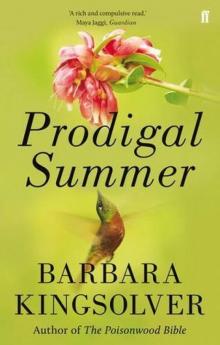 Prodigal Summer: A Novel
Prodigal Summer: A Novel Animal Dreams: A Novel
Animal Dreams: A Novel The Poisonwood Bible
The Poisonwood Bible High Tide in Tucson
High Tide in Tucson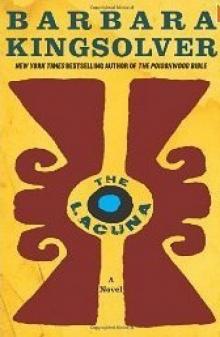 The Lacuna
The Lacuna The Bean Trees
The Bean Trees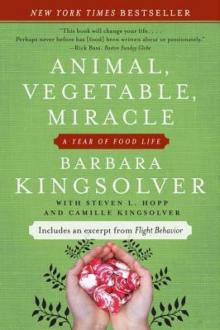 Animal, Vegetable, Miracle: A Year of Food Life
Animal, Vegetable, Miracle: A Year of Food Life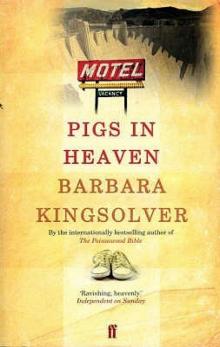 Pigs in Heaven
Pigs in Heaven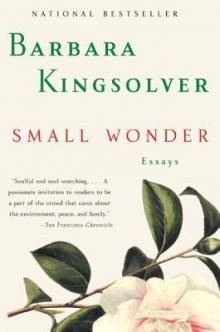 Small Wonder
Small Wonder Flight Behavior
Flight Behavior Homeland and Other Stories
Homeland and Other Stories How to Fly (In Ten Thousand Easy Lessons)
How to Fly (In Ten Thousand Easy Lessons) Unsheltered
Unsheltered Animal Dreams
Animal Dreams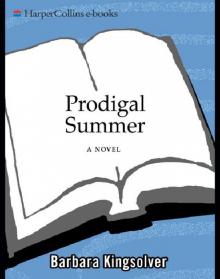 Prodigal Summer
Prodigal Summer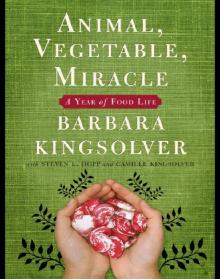 Animal, Vegetable, Miracle
Animal, Vegetable, Miracle